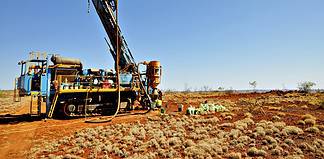All images: Bounty Mining
BY: JESSICA CUMMINS
In 2015, Bounty Mining found itself in voluntary administration; now the company has become a miner to watch, recently relisting on the ASX, with an expanded portfolio in central and far north QLD.
SINCE completing the landmark acquisition of Cook Colliery and Minyango in late 2017, metallurgical coal miner and developer Bounty Mining has gone from strength to strength.
After a tough couple of years, on 15 June the miner was readmitted to the ASX, raising $18 million in an IPO at an issue price of $0.35 per share.
The listing represented a turnaround for the company, and a shot in the arm for its projects in the development pipeline, including Cook North, Minyango, and Wongai.
Bounty chairman and chief executive Gary Cochrane said this year the company had “achieved a series of milestones”.
“We started coal mining by the 24th of January; then there was first shipment, the first railing, and then we had the stock market listing, and now we have introduced the sunken machine,” Mr Cochrane said.
“We are in a strong position to grow Bounty’s production profile and develop the company into a leading Australian producer and exporter of hard coking coal, a product that attracts a premium price.”
With a five year vision to become a 5mtpa coal producer, Mr Cochrane said the company remained focused on ramping up production at Cook Colliery and Cook North, while developing Minyango, Wongai and other opportunities.
Cook Colliery
Cook, a premium metallurgical coal mine, was previously owned by Caledon Coal from 2006 to 2017 before a major flooding event submerged its longwall, placing Caledon in voluntary administration, and eventually liquidation.
The longwall was promptly dewatered but the mine was placed under care and maintenance shortly after.
Mr Cochrane said it was not until the mine was eventually placed for sale that the company decided to acquire the tenements for $31 million.
“We went and had a look at the mine and went into negations with Caledon from May last year,” Mr Cochrane said.
“It wasn’t on the market until it had its production problems.”
Previously, Cook was mined using the ‘linear mining’ method – a first for Australia, which uses a continuous haulage system, a belt storage magazine, mobile tail end and expandable belt support cartridges.
Bounty’s ownership of Cook saw it brought back into production as a bord and pillar style mining operation instead of the longwall.
Mr Cochrane said using multiple smaller mining units was less risky than one large machine in one area.
Since it’s reopening, Bounty has successfully mined 220,000 tonnes from January 2018.
“We had to recruit a workforce and find a whole lot of mobile equipment, which was very difficult – it just wasn’t available,” he said.
“We have all the equipment now and I would like to say we are halfway to where I would like us to be long term.”
In a separate transaction, the company acquired the assets associated with Cook Colliery from Glencore for $10 million which included the mining lease, rail loop, Glencore wash plant and coal marketing agreement.
Since then, Bounty has managed to upgrade the Koorilgah rail loop to full axle load, allowing full capacity of 8500 tonnes trains, which reduced operating costs by at least $5/tonne as it planned.
Mr Cochrane said this was part of the company’s overarching plan to ramp up production with more expansion plans expected in order to reach its targeted 2.2 mtpa rate.
The company spent $2m on the upgrade, which comprised the installation of new ballast, formation work, new sleepers, weightometer, and train overload facilities.
Prior to this, the rail loop had been downgraded to 20 tonne axle load due to a lack of maintenance.
This limited Bounty to using partly loaded trains carrying 5500 tonnes of coal at a time.
On 25 June, the company announced its first shipment of coal from the Port of Gladstone to China carrying 34,000 tonne of mid-volatile hard coking coal.
“We look forward to growing exports from Cook and taking full advantage of the underutilised infrastructure we have taken ownership of,” he said.
Early last month the first sumping machine commenced extracting coal from secondary working at Cook Colliery, which completed the major change in the mining systems between the previous owners longwall to Bounty’s multiple unit operation.
Minyango
The Minyango project is a large greenfields coking coal development to the south of the township of Blackwater and 10km from the Cook CHPP.
The project is expected to produce similar coking and thermal coal as Cook with an estimated mineral resource of 190mt.
Bounty plans to focus primarily on the Aries and Pollux seams for exploration within the area.
Wongai
Bounty’s Wongai early-stage Wongai project also showed promise.
The project, in the Laura basin in far north QLD currently has an estimated resource of 67.5 million tonnes and is expected to produce about 1.5 million tonnes per year of coking coal, over an expected mine life of 15 years
Expenditure in the near-term will be allocated towards resource delineation, pre-feasibility and feasibility studies, and the finalisation of the environmental impact statement.
Bounty has also ensured bord and pillar mining will take place at the project using continuous miners and shuttle cars.
Mr Cochrane said Wongai was the company’s longer term project, with discussions taking place with the QLD government on minor works on site.
Looking Ahead
With global consumption of hard coking coal expected to grow to 635mt in 2019, Bounty Mining was set to find its main export markets in China, Japan, India and Brazil.
As offtake agreements with Lido Trading and Xcoal have been secured, Mr Cochrane said Bounty will continue to look for other acquisitions synergies to its coking coal position in QLD.
“I’m confident in the coking coal market – it should be strong for quite a few years now, especially because there is another three to four years before the next mine is built,” he said.










































